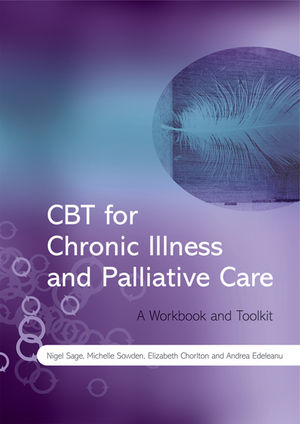CBT for Chronic Illness and Palliative Care: A Workbook and ToolkitISBN: 978-0-470-51707-9
Paperback
392 pages
May 2008
 This is a Print-on-Demand title. It will be printed specifically to fill your order. Please allow an additional 15-20 days delivery time. The book is not returnable.
|
||||||
Acknowledgements.
Introduction.
Part I: The Workbook: The Cognitive Behavioural Approach.
Chapter 1: What is the Cognitive Behavioural Approach?
Chapter 2: The Relevance of a Cognitive Behavioural Approach for People with a Life-changing Illness.
Chapter 3: Does Cognitive Behaviour Therapy Work? The Evidence Base.
Chapter 4: Communication Skills in Health Care.
Chapter 5: Cognitive Behavioural Communication Style.
Chapter 6: Guided Discovery: Using the Socratic Method.
Chapter 7: Assessment.
Chapter 8: Formulation.
Chapter 9: Deciding on a Course of Action: Part 1.
Chapter 10: Goal Setting and the Step-by-Step Process.
Chapter 11: The Practicalities of Setting Goals.
Chapter 12: Bringing About Change.
Chapter 13: Methods of Behaviour Change.
Chapter 14: Methods of Cognitive Change.
Chapter 15: Challenging Unhelpful Thoughts.
Chapter 16: Managing Emotions and Unpleasant Physical Sensations.
Chapter 17: Decision on a Course of Action: Part 2.
Chapter 18: Applying a Cognitive Behavioural Approach to Clinical Practice.
Part II: The Issues: Some Psychological Problems.
How to Use This Part of the Book.
Glossary of Everyday Terms.
Adjustment Difficulties.
Altered Body Image.
Anger.
Avoidance.
Denial.
Fatigue.
Fear of the Future.
Inactivity.
Indecisiveness.
Intrusive/Distressing Thoughts.
Lack of Motivation.
Loss of Pleasure or Ability to Enjoy Things.
Low Mood.
Low Self-Esteem.
Negative Outlook.
Pain.
Panic Attacks.
Special Note: Safety Behaviours.
Physical Tension.
Poor Concentration.
Problem Solving Difficulties.
Setbacks.
Sleep Difficulties.
Unassertiveness.
Worrying.
Part III: The Toolkit: CBT Methods in Practice.
Section 1: Techniques.
Activity Monitoring.
Assertiveness Skills.
Assessing Psychological Distress.
Attention Strategies.
Basic Counselling Skills.
Behavioural Change Methods: A Summary.
Behavioural Experiments.
Behavioural Rehearsal.
Believable Alternative Thoughts.
Breathing Control.
Challenging Unhelpful Thoughts.
Cognitive Change Methods: A Summary.
Denial: Strategies for Encouraging Acceptance.
Denial: Strategies for Engaging the Patient.
Denial: Strategies for Reducing Distressing Thoughts.
Denial: Suggestions for Questions to Ask.
Effective Communication Skills.
Emotional Expression.
Expressive Writing.
Graded Activities.
Listening Skills.
Mental Distraction.
Mindfulness.
Pacing.
Problem Solving.
Psycho-education.
Purposeful Planning.
Relaxation Exercises.
Respectfulness Skills.
Socratic Questioning.
Stimulus Control.
Weighing the Pros and Cons.
Section 2: Information Sheets.
Antidotes to Bad Days.
The Assertiveness Model.
Assertiveness Rights.
Assertiveness Techniques.
Bad Old Habits: Avoiding Relapsing Into Them.
Change: Bringing It About.
Change: The Desire for It.
Change: The Transition Curve.
Coping with Setbacks 1: Physical Health Setbacks.
Coping with Setbacks 2: Mental Attitude Setbacks.
Denial: Advantages and Disadvantages.
Experiential Learning Cycle.
Goal Setting and the Step-by-Step Approach.
Goal Setting: Examples.
Goal Setting Questions.
Mental Traps: Examining the Evidence.
Mental Traps: Examples of How to Get Out of Them.
Mindfulness Attitudes.
Mindfulness Exercises.
Pacing.
Pacing Examples.
The Reactions of Other People.
Reflective Practice Diary Guidance.
Relaxation: Mental Exercise.
Relaxation: Muscle Exercise.
Relaxed Breathing Exercise.
The Serenity Prayer.
Sharing and Mixing with Other People.
SMART Guidelines.
Socratic Questioning: Examples.
Stress: The Effect it Has.
The Stress Response..
A Vicious Cycle Model of Anxious Avoidance.
A Vicious Cycle Model of Anxious Preoccupation.
A Vicious Cycle Model of Hopelessness-Helplessness.
Section 3: Record Forms.
Event-Emotion-Thought Analysis Form.
Example of Event-Emotion-Thought Analysis Form.
Believable Alternatives.
Thought Record.
Pacing Record Form.
Denial: Assessing its Costs and Benefits.
Denial: Example of Pros and Cons Assessment.
Action Plan for Denial.
Goal Planning: Step-By-Step Action Plan.
Your Ideas for Goals.
Reflective Practice Diary.
References.
Index.



